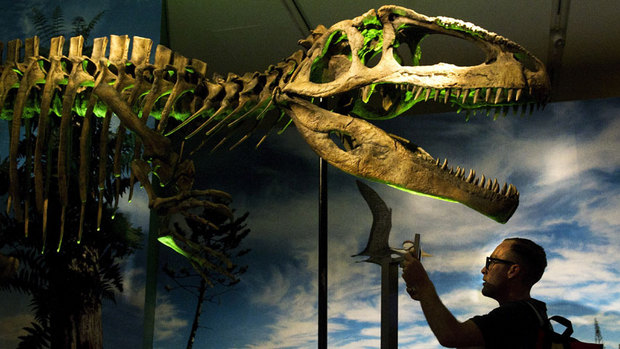When the Royal Ontario Museum asked David Evans to curate a new dinosaur exhibit, he didn't want to showcase species from the northern hemisphere that everybody knows.

The museum's new exhibit Ultimate Dinosaurs: Giants from Gondwana opens to the public on Saturday.
It features fossils, skeletons and 17 full-sized skeletal casts of dinosaurs from Gondwana, a continent that formed when the supercontinent of Pangea split into two halves.
The dinosaur casts are surrounded by murals that show them in their natural environments.
"In this exhibit, you'll meet some of the most unusual dinosaurs that ever evolved," said Evans, an assistant professor of ecology and evolutionary biology at the University of Toronto who oversees dinosaur research at the ROM.
"The dinosaurs on the newly formed supercontinent of Gondwana went their own, unique evolutionary direction."
Some of the features that distinguish the southern dinosaurs include tiny arms, sails down their backs, and small, crocodilian-like heads.
The exhibit will be the first time that many of these southern hemisphere dinosaurs will be shown in Canada.
It includes Futalognkosaurus, the largest dinosaur ever mounted in Canada. It's 33.5 metres long and weighed as much as 10 elephants when it roamed the earth.
'Augmented Reality'
It also uses Augmented Reality technology that allows visitors to scan the displays through a tablet screen provided, or through their own iPad, to see them become animated and covered in skin.
Visitors can also interact with two digital murals that react to their movements.
Janet Carding, the ROM's director and CEO, says this is the first time Augmented Reality technology has been used in this scale at a Canadian museum.
"Using these techniques, we're going to transport you to the beginning of the age of dinosaurs to experience these strange, new creatures in ways you wouldn't have imagined before," said Carding.
The dinosaur casts were created by Peter May, owner of Research Casting International, who also made the dinosaurs featured in the Jurassic Park films.
Each skeleton is comprised of about 300 bones and the casts can each be broken down into eight parts to be transported when the exhibit goes on an international tour following its Canadian debut.
May says some of the fascination we have with dinosaurs stems from how long they lived and how strange they look to us.
"They're so big, they're so vicious and they're so gentle, too," said May. "And they aren't around anymore, so I think that lets the imagination soar."
The exhibit runs until Sunday, March 17, 2013.
Source: The Canadian Press [June 20, 2012]